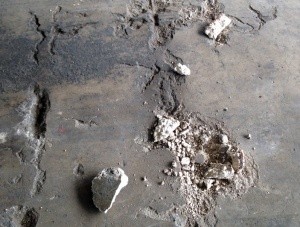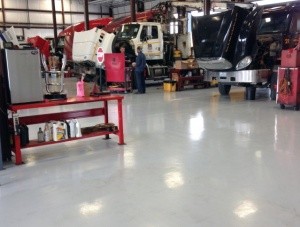A case for floor repair/recoat for a thin-film coating system
General industrial operations require floor coatings that are safe, light-reflectant, and able to stand up to general foot and cart traffic. When installed properly, with proper cleaning and maintenance, thin-film coating systems can provide long, useful service lives. Provided the concrete substrate is in good shape and structurally sound, you can easily repair small cracks and chips and recoat these types of systems. Among the most important factors that contribute to a floor coating’s service life is whether the concrete substrate was prepared correctly. Most manufacturers recommend a shot-blast or diamond grind of the concrete substrate to allow the coating system to properly anchor to the concrete. If the substrate was properly prepared and initial coating system was installed correctly, repair and recoat is a relatively simple and quick operation for a skilled installation contractor.
When it comes time to replace/resurface your industrial floor
For heavy-duty industrial applications, years of aggressive use and direct impact can badly damage a bare concrete floor. Cracks, pitting and deterioration of concrete can damage forklifts and equipment, presenting safety hazards throughout your plant. Additionally, process materials such as chemicals, oils and grease can saturate your concrete slab. This is a case where a concrete floor requires a more permanent, heavy-duty solution. The solution is to remove any existing coating system, aggressively prepare the existing substrate and “resurface” the concrete with a polymer mortar system.
A mortar/resurfacer floor system typically consists of a polymer primer followed with an application of a trowel-finished polymer mortar. This mortar is a blend of high-performance polymer resin combined with custom-blended aggregates or concrete powders. These systems are installed at a thickness of 3/16” to ¼”. Subsequent polymer topcoats are then applied as determined by the intended use of the floor area. These heavy-duty systems not only protect concrete substrates, they can resurface badly damaged concrete providing a long-lasting, stronger concrete cap. This new concrete cap is three times more durable than the underlying concrete substrate.
With a properly installed and well-bonded base mortar system, you have a functional system that can provide years of service. Best of all, when the topcoat dulls or wears from everyday use, you can apply a new topcoat relatively easily and economically, with quick turnaround. In most cases, a flooring crew can come in on a Friday evening, properly prepare your existing topcoat and apply a new coating over the weekend. You can be back in full operation, on a brand new floor, Monday morning.
Don’t know whether to re-coat, repair or replace your industrial floor? Our Industrial Flooring Self-Assessment Tool can help you determine the ideal solution for your unique application.




